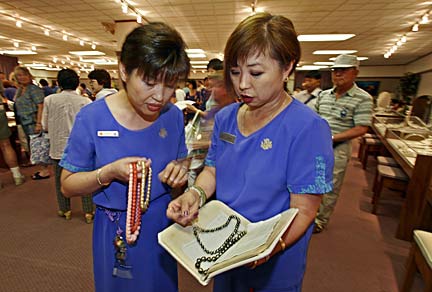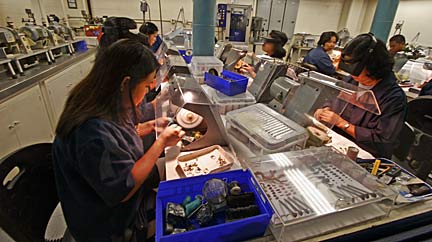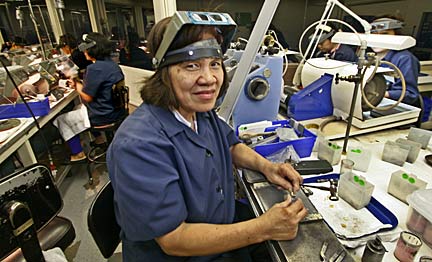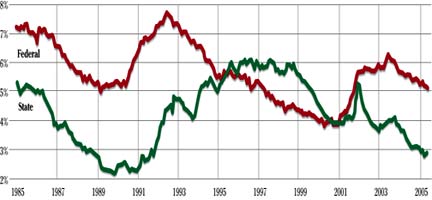|

|
Steady growth makes
for workers’ paradise
A tight labor market lets
employees maximize pay
and fringe benefits
Electrician Brandon Ahu said he's always telling apprentices not to take their union jobs for granted because they have no idea how bad things can get.
|
|
But Ahu, now 29, is now making more than $70,000 a year -- about a 70 percent raise -- with medical, dental and vision benefits. And he has the state's booming economy partly to thank for that.
On the other side of the labor market is Bob Taylor, president and chief executive of Maui Divers Jewelry. The business has expanded to 43 Hawaii locations from three since 1997, and sales have doubled in the past three years. But the rapid growth has left the company short by about 70 workers statewide, including more than 50 on Oahu. Taylor also has the state's economy to thank -- for both the company's growth and the lack of available employees.
The effect of Hawaii's low unemployment rate can be seen in storefronts everywhere. "Positions available." "Now hiring." "Career opportunities. Inquire within."
Given the alternative, it's a good problem to have since two months after 9/11, the state's seasonally adjusted unemployment rate was at a 2 1/2-year high of 5.2 percent. When the state's expansion, as measured by real personal income, was just gaining steam in 1997, Hawaii's jobless rate was hovering around 6 percent.
Now it's 2.7 percent, making it the lowest in the nation and nearly half the U.S. unemployment rate of 5.1 percent.
How did Hawaii go from high unemployment and near-empty beaches to help-wanted signs and packed hotels?
"The same way someone gets pregnant: the usual way," said Paul Brewbaker, chief economist for Bank of Hawaii.
"The Hawaii economy has had a fairly steady economic expansion that is through its eighth year, and after eight years of growth, it should not be surprising that unemployment should go from starting out high to ending up low," Brewbaker said. "To be sure, those eight years have been punctuated by shocks -- 9/11 was one of them, SARS was another one, Y2K was a fake one.
"But the point is that the overarching characteristic in the last eight years has been sustained growth."
The state's booming construction industry has been hiring at the fastest clip, increasing the number of hires by 9.7 percent, or 2,800 jobs, through May of this year compared with a year earlier.
Overall, job growth increased by 12,900 workers to 608,200 from a year earlier while the number of unemployed fell by 2,950, to 17,050.
For Ahu, the opportunity arose to trade in six years of nonunion experience for membership in the International Brotherhood of Electrical Workers Local 1186. The explosion of Hawaii's construction and real estate markets had created more demand than could be filled by island workers, and the IBEW was bringing in out-of-state union members, called travelers, to pick up the slack. The IBEW also was looking for local experienced nonunion electricians, which is how Ahu got recruited.
When Ahu joined the union as a journeyman electrician in June 2004, it was sort of like hitting the lottery for his wife, Danielle, who quit her bridal store job four months later.
"She was under some stress at work. And when she saw what kind of money I was bringing in, she did the math and figured that technically she didn't have to work," he said. "She called me up on her way home from work and said today was her last day."
Ahu, who is now wiring homes in a Ko Olina development for Honolulu-based Electricians Inc., said with his newly acquired benefits he was even able to go to the dentist recently for the first time in more than 10 years.
Maui Divers Jewelry has for years been paying employees $2,000 referral rewards if they recommend someone who eventually gets hired, Taylor said. The company periodically adjusts its wages and commission programs to remain competitive and offers an Employee Stock Ownership Plan as well. For salespeople, he said, wages can range from $25,000 for those starting out to $80,000 for the best salespeople.
"Because of our expansion, we've always been short of employees," Taylor said. "But it's becoming more and more difficult to find employees. We're short more now than we've ever been. We're short managers. We're short salespeople. We're short drivers."
Carol Pregill, president of the nonprofit Retail Merchants of Hawaii, said it is common for the 200 members represented by the trade association to have double-digit vacancies in their 2,000 storefronts.

Electrician Brandon Ahu left a nonunion job to join the International Brotherhood of Electrical Workers Local 1186, which found him a job with Electricians Inc. He got a significant pay raise, plus full benefits. He is doing electrical work on homes that are being built in Ko Olina. The same booming economy that has helped Maui Divers Jewelry grow to 43 locations also has made hiring tough. The company needs 50 more employees on Oahu alone. 
Manager Sung Higa and salesclerk Mimi Nakae get jewelry for a customer at the Honolulu design center.
Actually, the lowest unemployment rate in the past two decades was in October and November 1989, when the seasonally adjusted level was at 2.2 percent both months. A seasonally adjusted rate takes out the effects of changes associated with the seasons, such as teachers being out of school.
Brewbaker said Hawaii's current unemployment rate could drop about another half-percentage point but not much further.
"The implications are that it's great for job seekers," he said. "There's never been a better time to get a job."
Brewbaker said it is tough for employers, though.
"It's made even harder by the fact that qualified workers have so many other opportunities to consider," he said. "But I don't think anybody sheds any tears for employers in a situation like this. Having economic conditions that are favorable for employment are sort of the Holy Grail."
Richard Stula, co-owner of Teddy's Bigger Burgers with partner Ted Tsakiris, said they had to close their restaurant at Alakea and Queen streets in March after 15 months of operation because they could not get enough workers to come downtown for a part-time shift during the busy lunch hours. The restaurant was only open from 11 a.m. to 3 p.m.
"Ted and I were working down there five days a week because we couldn't get the bodies down there," Stula said. "To entice people, we put signs up at our other stores, and we offered to pay a couple extra dollars an hour and to pay bus fare. Sometimes, we'd end up with two people less than we needed to serve the customers. We wanted to serve the product to our standards, and it was hard sometimes because we didn't have the numbers to do it. It was actually profitable, but not enough to make it worthwhile for us being down there five days a week."
Wendy Burkholder, executive director of the Consumer Credit Counseling Service of Hawaii, said the organization has seen signs that individuals are better off than they were a year ago. Through May, Consumer Credit Counseling had to establish repayment plans for 105 individuals in trouble compared with 132 through the first five months of 2004.
Burkholder also said that the number of people seeing Consumer Credit Counseling because of reduced income -- when one person in the family loses a job -- had decreased to 37 for the first five months of the year compared with 94 a year earlier.
ABC Stores President Paul Kosasa said an 8.4 percent increase in visitor arrivals this year over a year ago has put a strain on the employee ranks at the company's 52 Hawaii stores, which include 36 in Waikiki.
"Everyone is having a challenge because tourism is up," he said. "It's a business, so consequently, there's more openings to fill our business needs. Our human resources department has been going to as many job fairs as possible."
ABC, which also offers referral rewards, is looking to hire about 80 additional people statewide.
"There's no comparison between now and after 9/11," Kosasa said. "It's very busy now, and post-9/11 the economy was struggling to get back on its feet. There were some businesses that folded post 9/11. Now it's a thriving economy."
Not every business is feeling the pain of trying to find workers.
Keith Vieira, senior vice president of Starwood Hotels & Resorts Worldwide Inc. in Hawaii, said turnover among the hotel chain's 5,500 workers is at an all-time low. The company operates the Sheraton and Westin chains.
"I don't think that's related to the economy being so good," he said. "I think it's more related to the fact that Hawaii continues to be a costly place to live, and it's important to maintain ongoing employment. Therefore, we have to provide more opportunities. We have a talent review that keeps us continually informed of a manager's career aspirations and allows us to plot on a five-year plan the next promotion or lateral opportunity for them."
Vieira said Starwood also has reinstituted its management trainee program for the first time since 1990. He said Starwood is bringing in between 15 and 20 college graduates from both Hawaii and the mainland into the company's management training programs to fill future needs.
"We will continue our emphasis of building from within, but there's no question this is a high employment period and it's harder to attract new talent," he said.
Sheila Sumida, head of the human resources division at First Hawaiian Bank, said it is getting tougher to find people but that turnover is not any higher than usual. The hardest positions to fill are at the entry level, such as tellers, she said.
Reid Fujita, president of Cinnamon Girl, said the women's and girls' clothing boutique has had little turnover at its six stores.
"We may have less people applying for an advertised job than in the past, but that seems to be a symptom of the low unemployment rate," Fujita said. "I don't think we have significantly more openings now than two or three years ago. We try to pay our people well for their positions, and we try to offer incentives."

Maui Divers Jewelry pays employees $2,000 for each person they refer who gets hired. Here, workers polish black coral and other jewelry.
Nena Della stamps a design on a piece at Maui Divers Jewelry, which is short about 70 employees statewide.
"It's always the case that when the unemployment rate is down to 3 percent or down to 2 percent, it's accompanied by higher local inflation," he said. "They're really two sides of the same coin. They reflect common forces that while creating strong economic conditions are also building inflationary pressures."
He said increased worker mobility, along with improved technology, has changed the character of the workplace and increased productivity.
However, it was Hawaii's lack of technology that actually allowed the state to recover from the post-9/11 downturn faster than the mainland, Brewbaker said.
"The mainland had a much stronger period of upswing in the late '90s and had a much sharper downturn in the early 2000s -- both for the same reason," he said. "A lot of the mainland was hooked up on the technology wave, and Hawaii wasn't.
"Hawaii was riding a big tanker board, and the mainland was riding a little thruster. So when the technology wave petered out, the mainland bogged, and Hawaii kept cruising on its longboard. So it sort of surfed through the ups and downs of the technology bubble and emerged this decade just cruising."
Along the way, Brewbaker said, residential real estate activity and construction were ramping up, and tourism was fighting to recover from 9/11 and the shock of the mainland recession.
"Now that we're this deep into the expansion -- eight years into it -- construction and tourism seem to have momentum, and they've been joined by defense," Brewbaker said. "So, how did we get to the lowest unemployment rate in the country? Steady, sustained economic growth that has absorbed unemployed labor resources and put everybody back to work.
"So we came from behind the rest of the country and are now in the lead. That doesn't mean we'll stay there. But given the choice, I'd rather be here than there."
NATIONAL, STATE UNEMPLOYMENT HISTORY
 |
Tonight on KITV 4 News at 10 ...
E-mail to City Desk
[News] [Business] [Features] [Sports] [Editorial] [Do It Electric!]
[Classified Ads] [Search] [Subscribe] [Info] [Letter to Editor]
[Feedback]


